· 10 ·
Windsor Furniture Making in Boston:
A Late but Innovative Center of the Craft
NANCY GOYNE EVANS
The story of Windsor construction begins in England, where during the 1710s the craft evolved. By the early 1720s, the Windsor chair was a recognized form. English Windsors were owned in Philadelphia possibly as early as 1726, when Patrick Gordon arrived with his household baggage from London to serve as lieutenant governor of Pennsylvania. The first American construction occurred in the early to mid-1740s, and domestic production was slow but steady into the early 1760s. The English Windsor provided the overall inspiration, with turned work derived from the slat-back rush-bottom chair tradition and the use of carved crest terminals borrowed from formal design. In the years preceding the Revolutionary War, the Philadelphia models that inspired postwar Boston production were in place, featuring high backs or rounded sack-backs and long baluster leg turnings accompanied by tapered feet.1
Evidence of Philadelphia Windsor seating in pre-revolutionary Boston appears in early shipping records. In September 1763, the sloop Deborah entered Boston Harbor from Philadelphia, followed the next year by the schooner Jane. Both carried small numbers of Windsor chairs to be unloaded at one of the many wharves dotting the waterfront. Sloops and schooners were the common vessels of the coasting trade. Other facets of this early mercantile pursuit in Windsor seating are described in Boston probate records. Daniel Malcolm, who died in 1769, owned two Windsor chairs and was part owner of three sloops. Samuel Parker owned a sloop as well as two Windsor chairs at his death in 1773. Philadelphia or Newport, Rhode Island, were the likely sources of the mariners’ Windsors, which at this date were large armchairs. That Parker also had an interest in land near Buzzard’s Bay strongly suggests that his Windsors originated in Rhode Island.2
Correspondence between merchants in Boston and Philadelphia provides further insight into the importation of Windsor chairs during the 1770s. Early in 1772, John Andrews of Boston arranged with his brother-in-law William Barrell, a New Englander working in Philadelphia for the Boston firm Amory and Taylor, to ship Philadelphia Windsors to Boston. A first lot, according to Andrews, arrived “much defac’d.” Carried on deck, one had a split bottom and another had exchanged its paint for tar. Andrews suggested that a second lot of Windsors, ordered from Joseph Henzey, be placed in the cabin for safe passage. A special order from Andrews in February 1773 called for two chairs made higher in the back to permit his friend Dr. Loring “to take a nap in, upon occasion.” To prevent misunderstanding, Andrews sketched the bow of a sack-back Windsor at the letter’s end (fig. 1). Little more than six months later, Andrews had another request: “My principal motive in writing this is to oblige Mr Breck who is about moving into Capt Ingraham[’s] house at the back of B[e]acon Hill, and wants six chairs of the same kind as you sent me last with two high back’d ones, which should be glad you’d send me as soon as possible, as one of his rooms must remain unfurnish’d till they come.”3
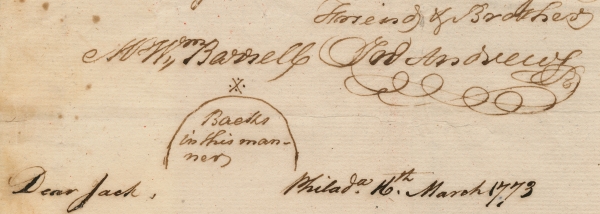
FIG. 1. Detail of a letter from John Andrews, in Boston, to William Barrell, in Philadelphia, February 26, 1773. Massachusetts Historical Society; Andrews-Eliot Papers.
During the Revolutionary War, the occupation of Boston prompted some merchants to leave the city to pursue business elsewhere. Samuel Salisbury joined his brother Stephen Salisbury I in Worcester, Massachusetts. While in that town, Samuel received a communication early in 1779 from his brother-in-law Samuel Barrett of Boston, asking him to purchase “6 Green Chairs” from a local estate, adding “if made at Philadelphia.” During this period, Stephen Salisbury may have acquired the green Philadelphia sack-back Windsor he sat in when painted by Christian Gulliger.4
Early documentary evidence of Windsor production in Boston is an illustrated advertisement that Ebenezer Stone placed in the Independent Chronicle on April 13, 1786 (fig. 2). Offering “Warranted Green Windsor Chairs” from his shop on Moore’s Wharf, Stone guaranteed that his chairs were “painted equally . . . well as those made at Philadelphia.” Little more than a month later, on May 18, Stone found a customer for his green chairs in David S. Greenough, who purchased six. Green was the universal color of the Windsor chair, from its early use on seating in the grounds and gardens of English country estates to its American use throughout most of the eighteenth century.5
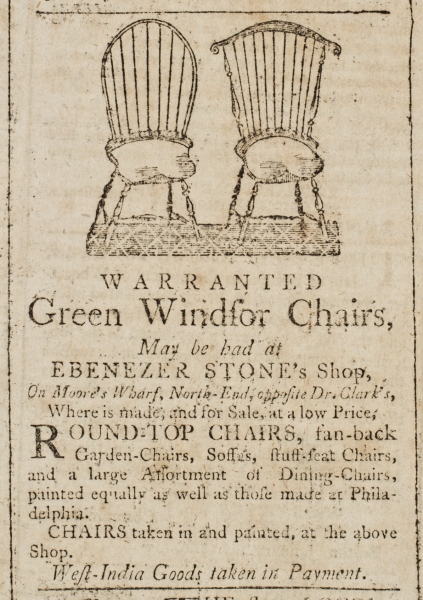
FIG. 2. Advertisement of Ebenezer Stone (b. 1763). From Independent Chronicle and the Universal Advertiser (Boston), April 13, 1786. American Antiquarian Society.
Stone followed this advertisement with another in September 1787, using the same woodcut of two side chairs and noting his move from Moore’s Wharf to Fore Street. An early high-back armchair branded by Stone and a sack-back chair with a tall back extension branded by Thomas Blackford (fig. 3) demonstrate these craftsmen’s close relationship to the Philadelphia product, seen in their long baluster turnings and short tapered feet. Blackford’s extension-back chair bears an unusual feature. The bow face has been shaved flat, spanning the long spindles that extend above the arm rail; this was done perhaps to make the chair more comfortable for resting since support for the head and arms is in place.
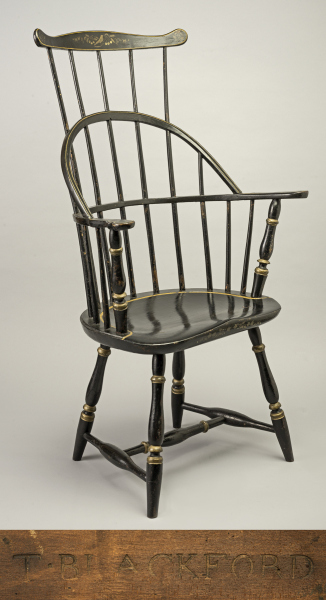
FIG. 3. Sack-back Windsor armchair with back extension and detail of brand, Thomas Blackford (active ca. 1784–89), Boston, 1784–89. Soft maple, hickory, white oak; h 45¼, w 26¼, d 20. Winterthur Museum; Museum purchase acquired in part through trade of object given by Mrs. John J. Bradley (1986.0002).
Stone seems to have died in his twenties, and Blackford is something of an enigma. The latter may have worked as early as 1784; he did business briefly in 1786 with Daniel Rea Jr., an ornamental painter of Boston, from whom he purchased painting supplies. Blackford was responsible for a sack-back chair without a back extension that bears a label on the seat bottom stating that he was “Lately from Philadelphia.” The label continues, “Having left Mr. Stone, Joiner, at the North-End, [he] has opened a Shop at Mr. Rogers’s, in Water-Street, Boston, Where he carries on Windsor Chair-Making in all its different branches, of the newest and best fashions.” Aside from these references, nothing more is known of Blackford.6
Evidence of a new influence on Boston Windsor production was apparent in the early 1790s. A sack-back chair branded by Samuel Jones Tuck(e) (fig. 4), while retaining a Philadelphia character in overall form, has short full-bodied baluster turnings and swelled feet indicative of Rhode Island influence. Shipping records document the exportation of “green” and “Windsor” chairs (synonymous terms) from Newport and Providence to Boston during the early 1790s. Tuck’s chair also exhibits one of two stylized independent features of short duration that marks some of the best Boston Windsor production of the early 1790s—the unusually large blocked swells of the side stretchers. In 1795, Tuck became an original member of the Massachusetts Charitable Mechanic Association, an organization whose purposes were “promoting mechanic arts and extending the practice of benevolence.” He expanded his business to include imported painting supplies and, like many Windsor-chair makers, also produced fancy chairs with woven bottoms.7
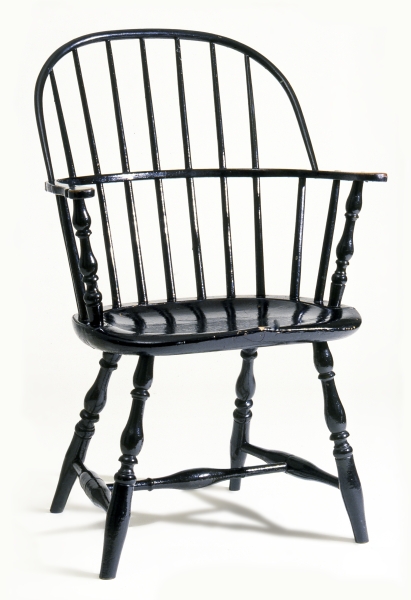

FIG. 4. Sack-back Windsor armchair and detail of brand, Samuel Jones Tuck(e) (1767–1855), Boston, 1790–98. White pine, other unidentified woods; h 37¼, w 24¾, d 15⅞. Collection of Thomas Rentschler. Photo, Winterthur Museum.
A specialized form—a two-seated settee as tall as it is broad (fig. 5)—exhibits the second of the specialized features that mark some Boston Windsor production of the early 1790s. The feature to be noted is the central swells of the two medial stretchers, flanked closely by small turnings of pronounced cylindrical form. Here, the Rhode Island–style leg turnings eliminate the spool and ring in the lower part, emphasizing the verticality of the design, which is further heightened by a narrow back structure flanked by out-swept arms that follow the curves of the seat. The final touches are the sawed pattern of the arms, with their circular pads and long, angular oxbow rail returns, and the masterly shaved and carved crest rail.
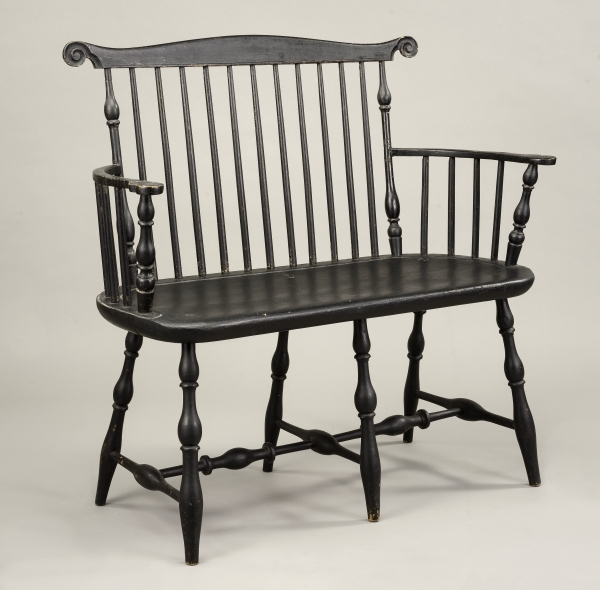
FIG. 5. Fan-back Windsor settee, Boston, 1795–1800. White pine, maple, ash, white oak; h 36¼, w 38, d 16¼. Winterthur Museum; Museum purchase (1980.0008).
A well-formed fan-back side chair of the mid-1790s, which has the Boston medial-stretcher feature, is reasonably attributed to William Seaver, another early vernacular chairmaker of Boston, based on his documented work of this period (fig. 6). Fan-back chairs are noted in two commissions received by Seaver in 1794. The first, placed in January, was for eighteen chairs. A second order for sixty chairs followed in October (fig. 7). Joseph Russell, a trustee of the first Boston Theatre on Federal Street, purchased the pieces for the commodious brick and stone structure built to designs by Charles Bulfinch. A 1797 inventory of the theater’s furnishings indicates that the chairs stood in the “Hall,” a 36-foot-long multipurpose room in the Ionic order, adjacent to the “Great Entry.” The room was heated by a fireplace and a “Small Iron Stove”; seven “Large tin hanging Candlesticks” supplied light after sundown. Unfortunately, the building and its contents were destroyed by fire on February 2, 1798.8
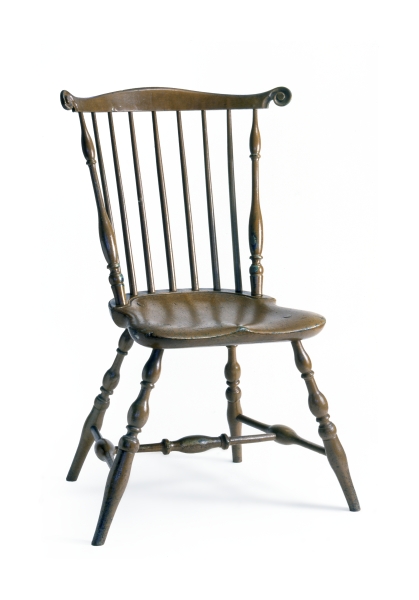
FIG. 6. Fan-back Windsor side chair, D. Danforth (owner brand), attributed to William Seaver (active 1793–1837), Boston, 1793–1800. Unidentified woods; h 35½, w 2113/16, Seat d 16¼. Present location unknown. Photo, Winterthur Museum.
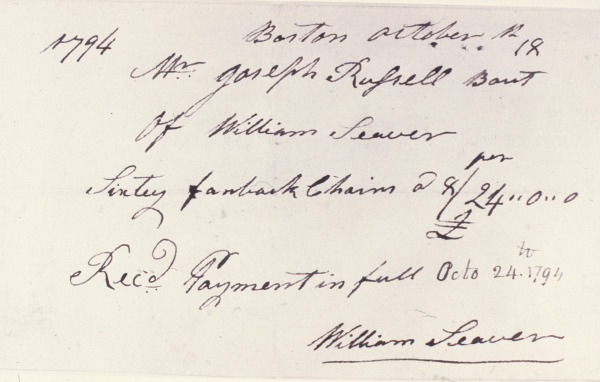
FIG. 7. William Seaver bill to Joseph Russell, agent for Boston Theatre, October 18, 1794. Boston Theatre Papers; Courtesy Trustees of the Boston Public Library/Rare Books.
By 1799, Seaver had formed a partnership with Nathaniel Frost that continued until 1803. The shop, at the sign of the “Golden Chair” on State Street, was adjacent to Long Wharf. Windsor work in the new bamboo style was standard production, but the partners also created a small body of highly innovative furniture, illustrated here in two examples. The curved medallion-ornamented stretcher of the side chair (fig. 8) likely reflects inspiration from imported English Windsors. The swelled feet seem a holdover of earlier Rhode Island design. The nodular spindles add visual interest to the chair back, although they lack a flare at the base (seen in the cradle, fig. 9, discussed below). The even number of spindles is unusual, both in Boston work and in that of other geographic areas. Seven or nine spindles are the norm in bow-back chairs of the late eighteenth century, and part of the partners’ other work in the curved-stretcher pattern has nine spindles. Some curved-stretcher chairs have arms, and at least one set of six side chairs is known. Another set of six bow-back, bamboo-style side chairs marked by Seaver and Frost employs crossed stretchers. One stretcher is rear-centered by a small grooved ball; the second stretcher is a rod that passes through the ball. Individual examples also are known.9
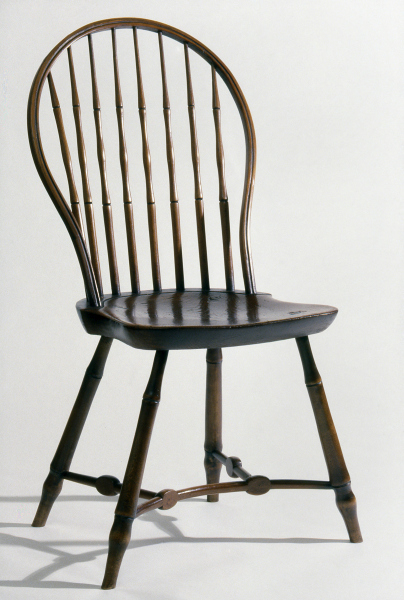
FIG. 8. Bow-back Windsor side chair, attributed to William Seaver and Nathaniel Frost (partnership 1799–1803), Boston, 1799–1803. Woods and dimensions not recorded. Present location unknown. Photo, Winterthur Museum.
An extraordinary cradle bears two paper labels of Seaver and Frost, printed with a State Street address that was current only between 1799 and 1802 (fig. 9). The cradle’s structure is a series of chair backs arched and curved laterally, two creating the hood and another reduced in size to form the foot. The tall ornamental legs are similar to those on the chair in figure 8, and the short stretchers are premier examples of the Boston blocked swell, interpreted here with delicate modeling. The cradle retains its original pale-yellow paint, a color that became popular with the introduction of simulated bamboo work. Delicate black penciling (pinstriping) fills the grooves of the bamboo work, forms a thin line at the front arch of the hood and on the wavy side pieces that connect the hood and foot, and outlines the two sides of the rockers. The branded initials “AHG” on the face of the foot stretcher are those of an unidentified original owner.
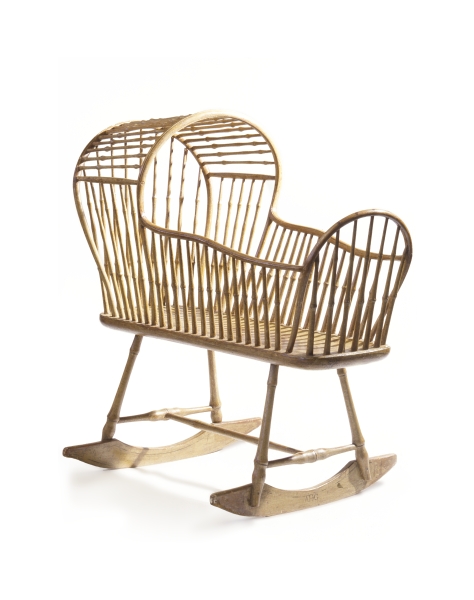
FIG. 9. Child’s tall Windsor cradle, William Seaver and Nathaniel Frost (two labels), Boston, 1799–1802. Woods not recorded; h 37½, l 36, w rockers 19. Collection of Gwynne G. McDevitt. Photo, Winterthur Museum. This cradle retains its original pale-yellow ground.
William Seaver appears to have been involved as defendant in several lawsuits. One suit charged that he owed David Tilden, Esq., for cordwood delivered in 1803 and 1804. As a result, an action was initiated in 1804 in the Inferior Court of Common Pleas, and property was attached at Seaver’s shop. The list of shop contents, although not definitive, appears to be relatively comprehensive and provides insight into a business in active production. Of the 207 “Wood bottom Chairs” on the premises, 83 were painted yellow and another 46 were painted dark green and black. Straw-bottom chairs, in various stages of completion, numbered 176 items, with 16 chairs finished in black and gilt and another 50 painted yellow. Chairs with caned seats numbered 31 items, of which 6 were finished in white and gilt and 8 painted a dark color. Twelve fancy chairs wrapped “in Mats” were ready for delivery or shipment. In addition, the shop contained a large number of turned parts. A partial, though reasonably complete, list includes 2,675 chair legs, 4,117 rounds (stretchers), “565 rounds for backs” (spindles), “160 bows for backs” (whether long bows for bow-back chairs or short bows for square-back chairs is unknown), 3 bundles containing 600 rounds “more or Less,” 1,410 rounds, legs, and posts, and 337 “backs,” which may have identified back posts for square-back chairs. A particularly interesting entry is for “82 India Cane Bottoms,” which appear to have been prewoven seats on narrow frames ready to slip into and fasten into open chair bottoms. There were also “103 bottoms Wood” and another 21 identified as “Small,” likely for children’s chairs.10
When discussing Boston furniture, it is appropriate to take note of the adjacent craft community in Charlestown, which eventually became part of Boston. The town economy received a boost in 1786 with construction of a toll bridge across the Charles River, replacing a ferry, and its prosperity was further heightened in 1798 when the federal government chose it as the site for the U.S. Navy Yard. Early in 1799, the young chairmaker Thomas Cotton Hayward migrated from eastern Connecticut and settled in Charlestown. On May 25, George Davidson, an ornamental painter of Boston, debited Hayward for painting his shop sign. Like Samuel Tuck, Hayward became a member of the Massachusetts Charitable Mechanic Association. Early in his career, Hayward had a trade card printed to promote his business (fig. 10); dating from sometime between 1803 and 1811, it is one of only a few such advertisements made for a chairmaker before 1815. Aside from its patriotic overtones, the trade card illuminates Hayward’s production, which included both Windsor and fancy seating. The bow-back Windsor at the lower left has forward-scrolling arms, typical for the bow-back armchair; the square-back chair at the upper right signals a new direction in back design from about 1800. The fancy rush-seated chairs in the other corners describe design versatility, having back members of either vertical or horizontal form. Settees were framed with either wooden or woven bottoms.11
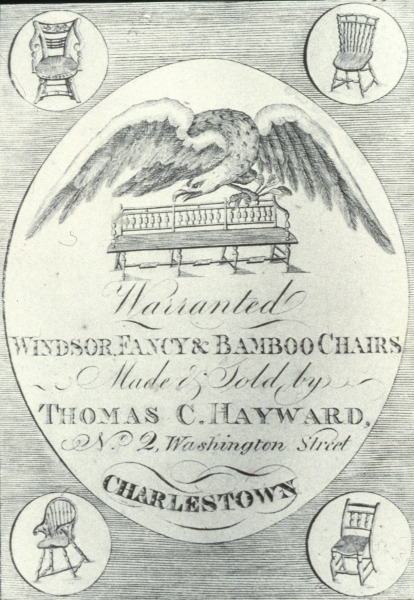
FIG. 10. Trade card of Thomas Cotton Hayward (1774–1845), Charlestown, Mass., 1803–11. Present location unknown. Photo, Winterthur Museum.
Amos Hagget also was a member of the Charlestown chairmaking community for a short period. He and Hayward were acquainted, though there is no indication they shared a working relationship. Hagget witnessed a real estate transaction in Charlestown in 1803; he married there in 1806 and baptized a daughter in town two years later. By 1817, he was living in Fredericton, New Brunswick. Hagget’s branded square-back chair, with its Charlestown place-name, is an excellent example of the new back design, here featuring a crest with a row of tiny, hollow-cornered square medallions between the double, or short, bows, so called because of their lateral curve (fig. 11). Many square-backs introduced a backward bend in the posts and spindles, and a new box-style stretcher system borrowed from the fancy chair replaced the former H-plan stretcher.12
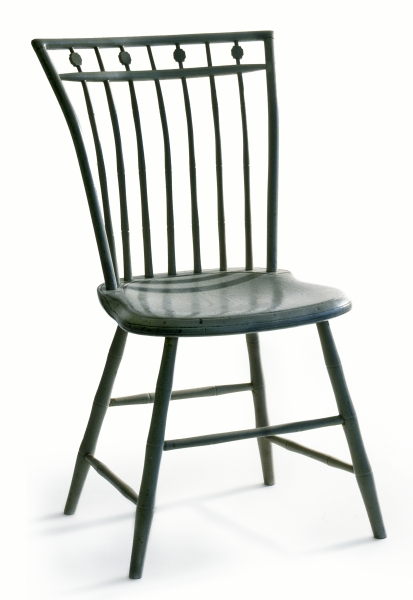

FIG. 11. Square-back Windsor side chair and detail of brand, Amos Hagget (active 1803–ca. 1817), Charlestown, Mass., 1803–10. Woods not recorded; h 34¾, w 19¼, Seat d 15⅝. Present location unknown. Photo, Winterthur Museum.
New square-back styles were in the market by 1810. One design with two short bows across the chair top has a wide, canted-corner tablet centered between the bows (fig. 12). Flat surfaces, such as the tablet, served as vehicles for painted and stenciled ornament, the focal point of vernacular chair design in the early nineteenth century. At midback are three closely spaced horizontal rods. The estate inventory of the Boston cabinetmaker and chairmaker Benjamin Bass Jr., who died in 1819, itemizes a large stock of vernacular seating, including nine “three-stick chairs,” as per the horizontal rods, perhaps like those seen here.13
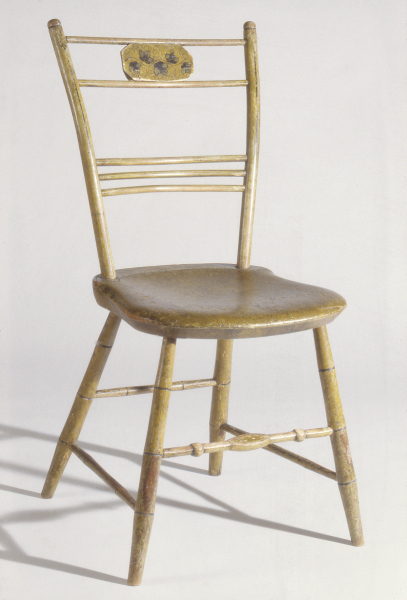
FIG. 12. Square-back Windsor side chair, Boston, 1810–15. White pine; h 34½, w 16¾, Seat d 15⅝. Shelburne Museum (1960-374a). Photo, Winterthur Museum. This chair retains its original medium bright-yellow ground with black and shaded gray.
A formal mahogany chair of Boston origin dating from about 1800 (fig. 13) was the source of a later crest design (fig. 14). In the London Chair-Makers’ and Carvers’ Book of Prices for Workmanship of 1802, which circulated in America, the formal design was designated as a “square back chair with elliptic-cornered top containing a tablet.” This tablet top, as interpreted in Boston Windsor seating, was popular throughout Massachusetts and northern New England in the 1810s and later. In Benjamin Bass’s 1819 inventory, 127 chairs are described as “tablet” or “bamboo tablet,” some noted specifically with “wood bottoms,” although probably all were Windsors (for Bass, see Morrison Heckscher’s essay in this volume). Appraisers valued 49 tablet chairs deposited at “Price’s Store” at $1.25 to $1.50 apiece. Those at Bass’s shop were valued at 60 cents apiece and lacked paint or ornament. The tablet-top Windsor chair (see fig. 14) retains its original mustard-yellow ground, with decoration and penciling delineating the central tablet. The dark brown penciling also fills the grooves of the bamboo work in the legs and stretchers, details the seat top, and forms a thin line down the face of each spindle.14
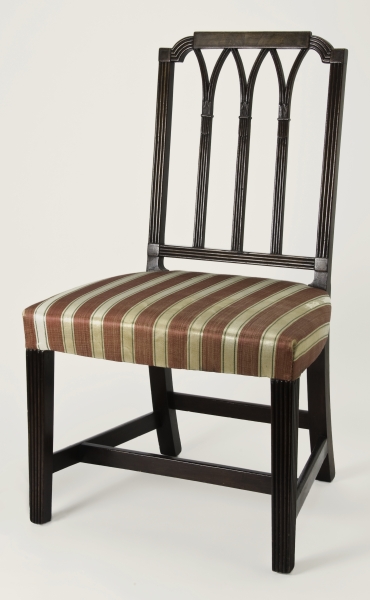
FIG. 13. Side chair, Boston, 1800–1805. Mahogany, satinwood, birch, maple; h 35¾, w 20½, d 19. Winterthur Museum; Bequest of Henry Francis du Pont (1957.0518.004).
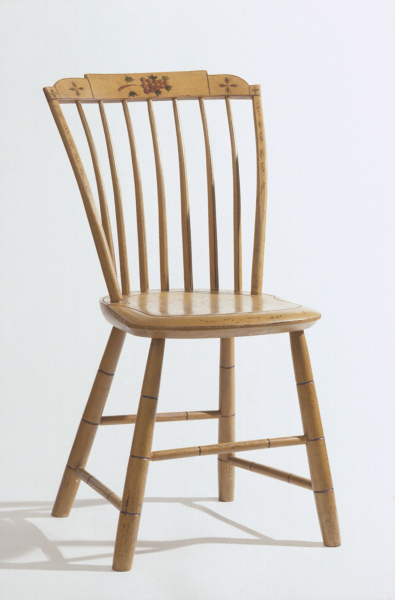
FIG. 14. Shaped tablet-top Windsor side chair, Boston area, 1812–20. White pine, other unidentified woods; h 33½, w 17¾, Seat d 15⅛. Present location unknown. Photo, Winterthur Museum. The pale mustard-yellow ground is original on this chair.
The 1820 Boston directory lists fifteen chairmakers working in the city. Substantial change is indicated just two years later in an 1822 volume produced by the same publisher. Eight chairmakers only are recorded and twelve newly identified establishments are denominated furniture dealers, stores, or warehouses. Times were changing by the 1820s: business was becoming highly competitive, the consumer market was expanding rapidly, and householders were seeking cheap goods in the marketplace. Demands are reflected in the product. The boardlike crest of a Windsor (fig. 15), with its tiny top scroll, is a nod to the neoclassical style in the luxury market of the 1820s (fig. 16). Windsor seats usually received token shaping, and bamboo styling often existed only in simulated grooves executed in paint. Nonetheless, the chairs were sturdy, and they appealed to a new and emerging market: organizations seeking quantity seating. Of unknown background, the Windsor in figure 15 is branded by Samuel Gragg, who in 1822 received a furniture commission from the Boston Athenaeum. During July and August, Gragg supplied this private library with fifty-two vernacular chairs, probably with and without arms, six more armchairs, six window stools, and one settee.15
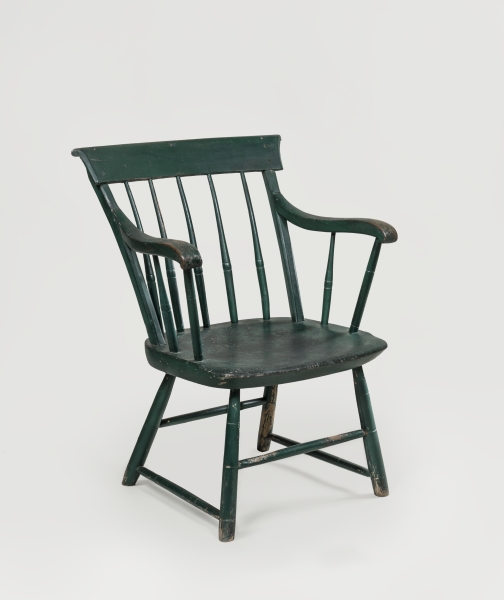
FIG. 15. Tablet-top Windsor armchair, Samuel Gragg (1772–1855) (branded), Boston, 1820–30. Mahogany, other unidentified woods; h 32, Seat w 20⅛, Seat d 19. Old Sturbridge Village Collections, Sturbridge, Massachusetts (5.1.932). Photo, Gavin Ashworth. The legs have been cut down.
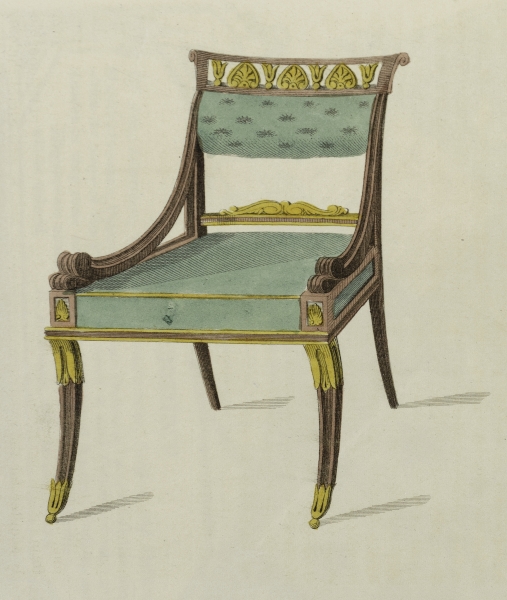
FIG. 16. Rudolph Ackermann, The Repository of Arts (London, 1809–28), pl. 28 (December 1814). Winterthur Library; Printed Books and Periodicals Collection.
Despite a late beginning in the Windsor market, Boston craftsmen produced some remarkable seating furniture. Perhaps near the top of the list is the tall rocking chair known, even in its day, as a Boston rocker (see fig. 19). Few rocking chairs of original construction were in the American furniture market before 1790; all had tall backs and woven seats. Windsor-chair makers experimented with the form during the 1790s, although it was not until the next decade that rocking began to catch on. The development of Samuel Gragg’s patented “elastic” chair, with its steamed and bent neoclassical contours, appears to have stimulated the market during the 1810s (see figs. 1, 2 on p. 180). The contemporary shouldered-tablet crest of Boston origin reached new heights when used in tall rocking chairs formed with an extra curve at the base of the posts and spindles (fig. 17). Customers could choose between painted arms and those made of a fine wood in a natural finish. Rocker attachment here is by slotting the feet, although tenoning and rabbeting were also used.16
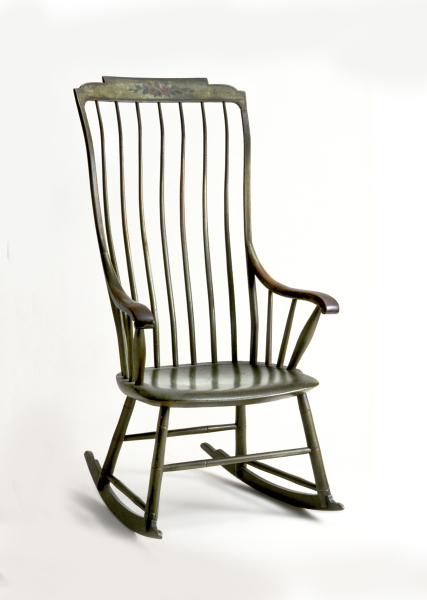
FIG. 17. Tall shaped-tablet rocking chair, possibly Samuel Gragg, Boston area, 1812–20. Woods not recorded; h 44¼, w 22¾, Seat d 17¾. Present location unknown. Photo, Winterthur Museum. The pale blue-green ground on this chair is old and possibly original.
During the late 1810s and 1820s, new crests appeared in the contoured-back rocking chair. The distinctive crest, termed a “crown top” in the period, appeared in the late 1820s (fig. 18). Adapted for formal seating from circulating design books, such as George Smith’s Cabinet-Maker’s and Upholsterer’s Guide of 1826, the profile soon entered the vernacular market. The final step in creating a true Boston rocking chair was the substitution of a “scrolled,” or “raised,” seat (fig. 19) for the standard plank bottom (see fig. 18). Stacked blocks at the back form the “rise”; a half “roll” attached at the front completes the scroll. This Boston rocking chair has advanced beyond the original crown top to introduce the next design change, a tablet top of loaf shape. An early reference to “high back Boston-made Rocking Chairs” occurs in an 1830 notice originating in Washington, D.C. Later in the 1830s, similar references appear in diverse locations, such as New York City and Downingtown, Chester County, Pennsylvania. Stenciled or painted fruit accompanied by leaves was a popular decorative choice, as shown here in both mediums.17
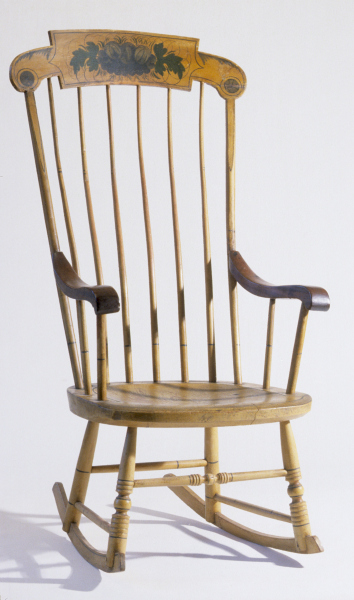
FIG. 18. Tall crown-top rocking chair, Boston area, 1828–35. Woods not recorded; h 44⅜, w 21, d 25⅜. Collection of Steven and Helen Kellogg. Photo, Winterthur Museum. The original mustard-yellow ground survives on this chair.
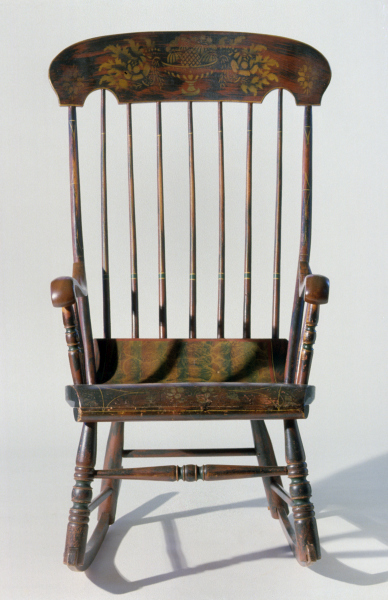
FIG. 19. Boston-style rocking chair with scroll seat, eastern Massachusetts, 1840–55. Woods and dimensions not recorded. Present location unknown. Photo, Winterthur Museum. This rocker retains its original imitation rosewood ground.
During his travels in America in the 1790s, the Duc de la Rochefoucauld-Liancourt observed that “Boston trades to all parts of the globe.” In truth, the city’s trade in vernacular seating was not equal to that of Philadelphia or New York. Nonetheless, Boston was a participant in both the coastal and foreign export trade in Windsors. In the postrevolutionary coastal trade, a small but steady market was the Canadian Maritime Provinces, with Liverpool, Nova Scotia, the most common destination. Cargoes were small, varying from one to five dozen chairs priced from 83 cents to $2 apiece. The cheapest chairs may have been “knocked downs,” that is, chairs shipped unassembled for framing at their destination. Six chairs shipped aboard the schooner Argo in 1801 to Saint Johns, Newfoundland, formed a group identified as Windsors and were valued at $2 per chair.18
Other postrevolutionary eighteenth- and early nineteenth-century markets included the islands of the Caribbean and the Guianas of northern South America. The foreign trade was mostly in schooners, brigs, and ships, and at any given time the number of colonial markets in the Caribbean open to American shipping depended on the state of political affairs in Europe. Three schooners out of Boston headed for the Bahamas to deposit 10½ dozen vernacular chairs at New Providence and Andros Islands, off the southeastern coast of Florida (fig. 20), although trade with these and other British islands was often off limits after the Revolution. The best Caribbean market for Boston was Cuba, where the most frequent destination was Havana. Several vessels carried a total of nine dozen framed Windsors there, augmented by chair parts described as “Chairs Qty [Quantity] materials” in the schooner Hero and “Chair Stuff 4 Bxs” in the Patty. Two other Cuban destinations for chair cargoes were Matanzas and Santiago de Cuba. In 1799, Grand Cayman Island, south of Cuba, received a cargo of fifty-six chairs valued at $1 apiece. On the neighboring island of Hispaniola, comprising Haiti and Santo Domingo (now the Dominican Republic), social unrest by the black community after 1795 diminished the chair trade, although there is record of two schooners and the ship Pattern depositing a total of 4½ dozen chairs and two settees.19
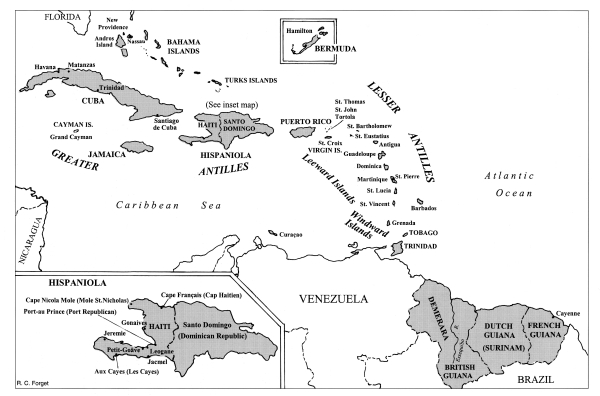
FIG. 20. Map of Caribbean and South American destinations of American Windsor furniture cargoes, 1783–1801. Drawing, R. C. Forget.
Farther east lie the Virgin Islands, and southeast of that group are the Leeward Islands. When the brig Francis left Boston for St. Thomas in 1801 laden with twenty-five dozen chairs valued at $450, the vessel likely conducted much of its business along the way, arriving at St. Thomas with considerably fewer chairs to retail or wholesale. Four voyages to St. Croix in other vessels accounted for small chair cargoes. The St. Croix records are of particular interest because they shed light on the time required to complete a round-trip voyage to the upper Caribbean. The brig Rainbow, under master Jonathan Williams, cleared Boston on April 10, 1799, for St. Croix. On July 16, the same vessel and master sailed again from Boston to St. Croix, indicating that a round-trip took slightly more than three months in good weather. Three islands in the Leeward group—St. Bartholomew, St. Eustatius, and Dominica—each recorded a cargo of chairs. Those delivered to St. Eustatius in 1793 were described in the ship’s manifest as “Chairs green 32” and cost $1 apiece, a fairly basic price.20
Only two destinations are recorded in this period for the Boston vessels heading to the more southerly Windward group. One was Martinique, a French island, where a cargo of fifty chairs carried there in 1797 was valued at $100, suggesting they were more ornate than the chairs deposited at St. Eustatius four years earlier. To warrant a price of $2 apiece, the grooves of the bamboo work and the seat tops may have been penciled (pinstriped) in a contrasting color. Trinidad, the southernmost Windward island, located off the northeast coast of Venezuela, recorded a cargo of chairs received in 1801 that were valued at $1.50 each. Other locations of the Boston Windsor trade were destinations bordering the Gulf of Mexico. The Gulf of Honduras, possibly Belize, was the destination of the brig Rover, which carried in the cargo six dozen chairs valued at $1 apiece. A like number of chairs was delivered to the more northerly gulf port of New Orleans, still a French possession, in 1801. The per-chair price of $1.94 indicates that New Orleans was a more sophisticated market. John Pintard, a New York City resident whose daughter lived in that city, stated during a visit in 1801 that “American manufactured Chairs & tea tables are getting into vogue.”21
Boston sea captains transporting chairs visited the Guianas, on the northern coast of South America east of Venezuela, at least nine times during the 1790s. Based on descriptions, chair cargoes appear to have been divided between Windsor and fancy chairs. The two dozen “Green” chairs landed at Cayenne, the capital of French Guiana, were priced at only 42 cents apiece and would have represented knocked downs, requiring framing. Four dozen “windsor” chairs shipped to the same port and valued at $1.19 apiece were framed, as were the twenty chairs at $1.10 each shipped to Demerara, the coastal county of British Guiana. A shipment of chairs to Essequibo, a long river bisecting British Guiana, probably was landed somewhere near the river’s estuary on the Atlantic Ocean. At $1.50 apiece, these also were Windsor chairs.22
The language identifying a group of chairs landed at Surinam, or Dutch Guiana, almost certainly describes fancy seating. The “3 dozn chairs & sophas” valued at $100 speaks to fancy furniture (the term sopha, rather than settee, was used to describe the long seats). When the snow Pacific Trader left Boston in December 1797 for Surinam, it carried “Chairs 100 Bundles” valued at $196. Some bundles probably contained two side chairs “nested” seat to seat, with vulnerable surfaces wrapped with hay bands or other material to protect the finishes; a few bundles may have contained a single armchair. Both the two-chair and single-chair bundles were then wrapped in woven matting. The number of chairs suggests they were Windsors; the careful packaging may indicate that some were fancy chairs. Boston newspapers reveal that well after 1800, trade in painted Boston chairs continued to achieve modest success. Advertising from their warehouse on Cornhill in 1811, Nolan and Gridley offered “3,000 Chairs, comprising a very complete assortment . . . which they will pack in shipping order and in the most careful manner.”23
Bostonians became acquainted with Windsor seating through imports from Philadelphia in prerevolutionary years, and that influence remained during the 1780s, when local production was initiated. Further design influence arrived during the early 1790s from Rhode Island, although by then Boston craftsmen had begun taking the lead in developing a local style. The usual sales were to private customers; however, directors of institutions, such as theaters and libraries, soon saw the wisdom in furnishing with the durable Windsor chair. During the nineteenth century, square-back Windsor seating introduced flat surfaces suitable for receiving the hand-painted and stenciled decoration that became the fashion. Among new design influences were the fancy chair, an English import, and books of design whose images, copied for formal seating, filtered down to the vernacular chair. From the late eighteenth century, Boston chairmakers successfully distributed Windsor seating in waterborne commerce well beyond local shores, reaching the islands of the Caribbean, ports in the Gulf of Mexico, and the north shore of South America. Perhaps the most outstanding contribution of the Boston chairmaking community was the development of a specialized tall chair with rockers that came to be known everywhere as a Boston rocking chair.

1. For more on the emergence of the English Windsor chair, its transfer to America, and early production in Philadelphia, see Nancy Goyne Evans, American Windsor Chairs (New York: Hudson Hills Press, 1996), 38–42, 65, 80–98.
2. Manifests of sloop Deborah and schooner Jane, Sept. 13, 1763, and Dec. 27, 1764, in shipping returns for Massachusetts, 1752–1765, Colonial Office, Public Record Office, London; Daniel Malcolm and Samuel Parker, estate records, 1769 and 1773, Suffolk County Probate Records, Boston.
3. John Andrews to William Barrell, June 22, 1772, Feb. 26, and Sept. 2, 1773, Andrews-Eliot Papers, Massachusetts Historical Society, Boston (hereafter MHS).
4. William Barrett to Samuel Salisbury, “Memo of Furniture to be bought at Pains,” n.d., and letter of acknowledgement, Apr. 1, 1779, Boston, Salisbury Papers, American Antiquarian Society, Worcester, Mass.; for the portrait of Stephen Salisbury I seated in a sack-back Windsor chair, see Evans, American Windsor Chairs, 245.
5. Ebenezer Stone, bill to David Greenough, May 18, 1786, Boston, Greenough Papers, MHS.
6. Ebenezer Stone, advertisement in the Massachusetts Gazette (Boston), Sept. 11, 1787; for Stone’s high-back armchair, see Evans, American Windsor Chairs, 349. Records for Ebenezer Stone are unclear. He appears to have been baptized in 1763, the son of Elias, a cooper of Charlestown, Mass. Ebenezer was appointed administrator of his father’s estate in 1786, although the appointment of a second administrator in 1791 probably indicates that Ebenezer had died by that date. One of the heirs of Elias’s estate was “Hannah, widow of Ebenezer”; Thomas Bellows Wyman, comp., The Genealogies and Estates of Charlestown, 2 vols. (Boston: David Clapp and Son, 1879), 2:907. Account with Thomas Blackford, 1786, Daniel Rea Jr. ledger, 1773–1794, Boston, Baker Library, Harvard University. For Blackford’s sack-back chair with paper label, see Skinner, Bolton, Mass., June 10, 1989, lot 73; the “Mr. Stone, Joiner” of Blackford’s label was not Ebenezer Stone, the Windsor-chair maker.
7. Joseph K. Ott, “Rhode Island Furniture Exports, 1783–1800,” Rhode Island History 36, no. 1 (Feb. 1977): 6, 9; manifest of sloop Lucy, Feb. 24, 1794, Newport, R.I., Newport Inward and Outward, Foreign and Coastal Entries, 1790–1795, Federal Archives and Records Center, Waltham, Mass.; Joseph T. Buckingham, comp., Annals of the Massachusetts Charitable Mechanic Association (Boston: Crocker and Brewster, 1853), 9, 10.
8. William Seaver, bills to Joseph Russell, Jan. 21 and Oct. 18, 1794, Boston Theatre Papers, Boston Public Library; theater inventory quoted in John Alden, “A Season in Federal Street,” in Proceedings of the American Antiquarian Society 65, pt. 1 (Worcester, Mass.: By the society, 1955), 52.
9. William Seaver and Nathaniel Frost partnership dates are in “The Taking Books of Assessors of the Town of Boston,” deposited by the city of Boston in the Boston Public Library; for a pair of curved-stretcher armchairs attributed to Seaver and Frost, see Antiques and the Arts Weekly (Newtown, Conn.), Skinner, Mar. 10, 1995. A set of six curved-stretcher side chairs attributed to Seaver and Frost was sold by Nathan Liverant and Son Antiques at the Winter Antiques Show, N.Y., Jan. 2013; a set of six cross-stretcher chairs branded by Seaver and Frost is in a private collection.
10. David Tilden, Esq., vs. William Seaver and Nathaniel Frost, May 1804, Inferior Court of Common Pleas, Suffolk County, Boston, Mass.
11. Account with Thomas C. Hayward, May 25, 1799, George Davidson waste book, 1793–1799, Boston, Old Sturbridge Village, Sturbridge, Mass.; Buckingham, Massachusetts Charitable Mechanic Association, 9.
12. Sale of real property by Thomas C. Hayward and wife, Elizabeth, to John Sweetser and George N. Vinal, July 8, 1803, witnessed by Amos Hagget, filed with Registry of Deeds, Middlesex County, Cambridge, Mass.; record of marriage of Thomas C. Hayward is in Mabel M. Swan, “Furnituremakers of Charlestown,” Antiques 46, no. 4 (Oct. 1994): 206; record of daughter Susannah’s baptism in Charlestown, Sept. 25, 1808, in Joseph F. Hunnewell, A Century of Town Life: A History of Charlestown, Massachusetts, 1775–1887 (Boston: Little, Brown, 1888), 226; Hagget advertisement of Sept. 30, 1817, at New Brunswick, Nova Scotia, in an unnamed newspaper; see Huia G. Ryder, Antique Furniture by New Brunswick Craftsmen (Toronto: Ryerson Press, 1965), 98.
13. Benjamin Bass, estate records, Sept. 27, 1819, Suffolk County Probate Records.
14. The London Chair-Makers’ and Carvers’ Book of Prices for Workmanship (London: T. Sorrell, 1802), as quoted in Charles F. Montgomery, American Furniture: The Federal Period (New York: Viking Press, 1966), 83, fig. 25; Bass, estate records, Suffolk County Probate Records.
15. The Boston Directory (Boston: John H.A. Frost and Charles Stimpson Jr., 1820 and 1822); Samuel Gragg, bills to Boston Athenaeum, July 1 and Aug., 1822, Boston Athenaeum.
16. Samuel Gragg, patent application for steamed and bent “elastic” chair, Aug. 31, 1808, in M. D. Leggett, comp., Subject-Matter Index of Patents for Inventions Issued by the U.S. Patent Office from 1790–1873, Inclusive (Washington, D.C.: Government Printing Office, 1874), 473. See also Michael Podmaniczky’s essay in this volume.
17. George Smith, Cabinet-Maker’s and Upholsterer’s Guide (London: Jones and Co., 1826), pl. 119; Richard Wright, advertisement in Daily National Intelligencer (Washington, D.C.), Oct. 20, 1830; a “Boston Rocking Chair” was in the “Front Bedroom Second Story” in the New York City home of Gerard Beekman, estate inventory, Dec. 7, 1833, Downs Collection of Manuscripts and Printed Ephemera, Winterthur Library; James Cannon, advertisement in Republican and Democrat (West Chester, Pa.), May 22, 1838.
18. Duc de la Rochefoucauld-Liancourt, Travels throughout the United States of North America . . . in the Years 1795, 1796, and 1797, 2 vols. (London: R. Phillips, 1799), 1:409; cargoes of chairs to the Canadian Maritime Provinces and Newfoundland are in Boston Outward Entries, 1790–1801, U.S. Custom House Records, French Spoliation Claims, National Archives, Washington, D.C.
19. Cargoes of chairs to the Bahamas, Cuba, Grand Cayman Island, and Hispaniola are in ibid.
20. Cargoes of chairs to the Virgin and Leeward Islands are in ibid.
21. Cargoes of chairs to Martinique, Trinidad, the Gulf of Honduras, and New Orleans are in ibid.; John Pintard is in David Lee Sterling, ed., “New Orleans, 1801: An Account by John Pintard,” Louisiana Historical Quarterly 34 (July 1951): 224–25.
22. Cargoes of chairs to French, British, and Dutch Guiana are in ibid.
23. Cargoes of chairs to Dutch Guiana are in ibid.; Nolan and Gridley, advertisement in Columbian Centinel (Boston), Feb. 16, 1811.
